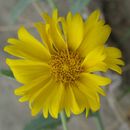Distribution in Egypt
provided by Bibliotheca Alexandrina LifeDesk
Nile region (Aswan), oases (Kharga) and Sinai (El Arish).
- author
- BA Cultnat
- provider
- Bibliotheca Alexandrina
Global Distribution
provided by Bibliotheca Alexandrina LifeDesk
Native to south and central America, naturalized in many regions of the Old World, pantropical weed.
- author
- BA Cultnat
- provider
- Bibliotheca Alexandrina
Habitat
provided by Bibliotheca Alexandrina LifeDesk
Waste ground, roadsides, edges of cultivation.
- author
- BA Cultnat
- provider
- Bibliotheca Alexandrina
Life Expectancy
provided by Bibliotheca Alexandrina LifeDesk
- author
- BA Cultnat
- provider
- Bibliotheca Alexandrina
Comments
provided by eFloras
Native distribution of Verbesina encelioides in the flora area is uncertain. Plants of Verbesina encelioides from ca. 100°W (e.g., c Texas) and eastward usually have auriculate petiole bases and have been called var. encelioides; plants from the west usually lack auricles and have been called var. exauriculata.
- license
- cc-by-nc-sa-3.0
- copyright
- Missouri Botanical Garden, 4344 Shaw Boulevard, St. Louis, MO, 63110 USA
Description
provided by eFloras
Plants 10–50(–120+) cm (annuals, internodes not winged). Leaves all or mostly alternate (proximal usually opposite); blades deltate-ovate or rhombic to lanceolate, 3–8(–12+) × 2–4(–6+) cm, bases broadly cuneate to ± truncate, margins coarsely toothed to subentire, apices acute to attenuate, faces strigoso-scabrellous to sericeous. Heads usually borne singly, sometimes 2–3+ in loose, cymiform or corymbiform arrays. Involucres ± hemispheric to saucerlike, 10–20+ mm diam. Phyllaries 12–18+ in 1–2 series, ± erect to spreading, lance-ovate or lance-linear to linear, 6–8+ mm. Ray florets (8–)12–15+; laminae 8–10(–20+) mm. Disc florets 80–150+; corollas yellow. Cypselae dark brown to blackish, narrowly obovate, 3.5–5+ mm, faces ± strigillose; pappi 0.5–1(–2) mm (0 on ray cypselae). 2n = 34.
- license
- cc-by-nc-sa-3.0
- copyright
- Missouri Botanical Garden, 4344 Shaw Boulevard, St. Louis, MO, 63110 USA
Synonym
provided by eFloras
Ximenesia encelioides Cavanilles, Icon. 2: 60, plate 178. 1793 (as enceliodes); Verbesina encelioides subsp. exauriculata (B. L. Robinson & Greenman) J. R. Coleman; V. encelioides var. exauriculata B. L. Robinson & Greenman
- license
- cc-by-nc-sa-3.0
- copyright
- Missouri Botanical Garden, 4344 Shaw Boulevard, St. Louis, MO, 63110 USA
Description
provided by Flora of Zimbabwe
Annual herb up to 1 m tall. Stems ribbed, hairy. Leaves mostly alternate, sometimes opposite, ovate-triangular, up to 10 × 7 cm, 3 veined from the base, with appressed greyish hairs, particularly below, discolorous; margin irregularly toothed. Petiole irregularly winged and auriculate on the stem. Capitula solitary at the ends of branches, c. 2.5 cm in diameter. Rays bright yellow, elliptic-obovate, c. 1 cm long, 3-toothed at the apex. Involucral bracts up to 1.3 cm long, linear, appressed greyish hairy.
- license
- cc-by-nc
- copyright
- Mark Hyde, Bart Wursten and Petra Ballings
- bibliographic citation
- Hyde, M.A., Wursten, B.T. and Ballings, P. (2002-2014). Verbesina encelioides (Cav.) A. Gray Flora of Zimbabwe website. Accessed 28 August 2014 at http://www.zimbabweflora.co.zw/speciesdata/species.php?species_id=160550
- author
- Mark Hyde
- author
- Bart Wursten
- author
- Petra Ballings
Worldwide distribution
provided by Flora of Zimbabwe
Native to Southwestern USA and Mexico; introduced into West Indies, tropical Africa and northern S Africa.
- license
- cc-by-nc
- copyright
- Mark Hyde, Bart Wursten and Petra Ballings
- bibliographic citation
- Hyde, M.A., Wursten, B.T. and Ballings, P. (2002-2014). Verbesina encelioides (Cav.) A. Gray Flora of Zimbabwe website. Accessed 28 August 2014 at http://www.zimbabweflora.co.zw/speciesdata/species.php?species_id=160550
- author
- Mark Hyde
- author
- Bart Wursten
- author
- Petra Ballings
Verbesina encelioides
provided by wikipedia EN
Verbesina encelioides is a flowering plant in the family Asteraceae. The species is native to many parts of the United States and Mexico.[1] It is naturalized in other parts of North America, the Middle East, Spain, Argentina, Australia and the Pacific islands.[2] Common names include golden crownbeard,[3] gold weed, wild sunflower,[4] cowpen daisy, butter daisy, crown-beard, American dogweed and South African daisy.[1][5]
The species responds strongly to disturbances on suitable sites and retards the development of other local species. Research has identified an allelopathic effect on radishes[6] which may explain its ability to dominate other species in some locations.
It is a larval host for the bordered patch.[7]
References

- license
- cc-by-sa-3.0
- copyright
- Wikipedia authors and editors
Verbesina encelioides: Brief Summary
provided by wikipedia EN

Verbesina encelioides is a flowering plant in the family Asteraceae. The species is native to many parts of the United States and Mexico. It is naturalized in other parts of North America, the Middle East, Spain, Argentina, Australia and the Pacific islands. Common names include golden crownbeard, gold weed, wild sunflower, cowpen daisy, butter daisy, crown-beard, American dogweed and South African daisy.
The species responds strongly to disturbances on suitable sites and retards the development of other local species. Research has identified an allelopathic effect on radishes which may explain its ability to dominate other species in some locations.
It is a larval host for the bordered patch.
- license
- cc-by-sa-3.0
- copyright
- Wikipedia authors and editors


